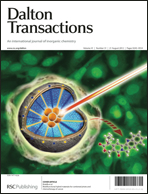Crystal structures and magnetic properties of (4,4′-phenylazophenyl)diammonium(crown ethers)[Ni(dmit)2]2 crystals†
Abstract
Sandwich-type hydrogen-bonded supramolecular dications (DAAz2+)([18]crown-6)2 and (DAAz2+)(dicyclohexane[18]crown-6)2 (DAAz2+ = 4,4′-(phenylazophenyl)diammonium) were introduced into [Ni(dmit)2]− anions via a diffusion method to form novel single crystals (DAAz2+)([18]crown-6)2[Ni(dmit)2]2 (1) and (DAAz2+)(dicyclohexane[18]crown-6)2[Ni(dmit)2]2 (2), respectively, which were characterized based on their crystal structures and magnetic susceptibilities. The molecular assembly structures and its physical properties were expanded in the use of a three component molecular network system. The two ammonium groups (–NH3+) of the DAAz2+ dication formed N–H+–O hydrogen-bonding interactions with the oxygen atoms of [18]crown-6 and dicyclohexane[18]crown-6. In the case of crystal 1, an alternating π-stacking interaction was observed for the [Ni(dmit)2]− anions, whereas orthogonal linear π–S interactions were detected for crystal 2. Temperature-dependent magnetic susceptibilities of crystals 1 and 2 followed the alternate Heisenberg antiferromagnetic chain (J = −15.8 K) and linear Heisenberg antiferromagnetic chain (J = −13.7 K) models, respectively.
![Graphical abstract: Crystal structures and magnetic properties of (4,4′-phenylazophenyl)diammonium(crown ethers)[Ni(dmit)2]2 crystals](/en/Image/Get?imageInfo.ImageType=GA&imageInfo.ImageIdentifier.ManuscriptID=C2DT30807J&imageInfo.ImageIdentifier.Year=2012)

 Please wait while we load your content...
Please wait while we load your content...